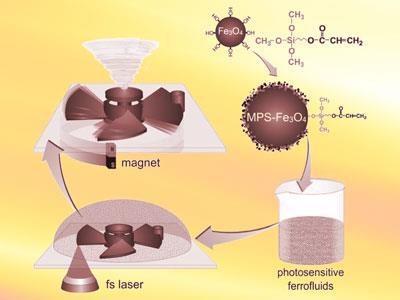Remote control micro-machines made by shining light on ferrofluids
Chinese researchers have made microscopic springs and turbines by shining light through ferrofluids - liquids containing iron nanoparticles. The novel shapes are hoped to find interesting uses in future, from drug delivery systems to complex electronics.

Making such micro-machinery has previously been done by etching silicon in a similar way to how computer chips are made. But silicon micro-machinery is difficult to control remotely, limiting its uses. Since these new shapes are made from polymerised iron, they can be rotated or moved around with external magnetic fields.
’The major breakthrough came when we chemically prepared a stable, homogeneous and transparent ferrofluid that would polymerise when exposed to light,’ says Hong-Bo Sun, who led the research at Jilin University in Changchun, China.
To do this, Sun’s team grafted a polymer called 3-(trimethoxysilyl)propylmethacrylate (MPS) onto the surface of iron oxide (Fe3O4) nanoparticles, before suspending them in a mixture of solvents to create a ferrofluid.
The team then carefully drew shapes in the liquid using an accurate laser, then washed away the remaining fluid to obtain the finished objects. Rather than being rigid or solid like silicon parts, the shapes are more rubbery and gel-like.

Around one-hundredth of a millimetre in size, the team demonstrated a fan-like turbine and a spring - although they are confident that more complex devices could be made in the same way.
’We are investigating the uses of these shapes in various fields,’ Sun told Chemistry World. ’For example, a microturbine has great potential to mix up microfluids and a remotely-controlled microdevice would be helpful in drug delivery.’
A unique system
Gary Friedman, who has designed similar microelectromechanical systems at Drexel University in Philadelphia, US, is impressed by the work.
’This method of making shapes using light is unique - and could be a big step towards producing some interesting new devices,’ he says. ’One possibility is machinery that can crawl around in the human body, and get to hard-to-reach places by using external magnetic fields as actuation,’ Friedman adds.
Yadong Yin, an expert on nanostructured materials at the University of California at Riverside, US, agrees. ’This paper provides a very useful method for the fabrication of magnetic microstructures whose movement can be manipulated using external magnetic fields,’ he told Chemistry World. ’The process can be carried out conveniently and efficiently without the need of stringent conditions, making it suitable for many practical applications.’
Lewis Brindley
References
H Xia et al, Adv. Mater., 2010, DOI: 10.1002/adma.201000542






No comments yet